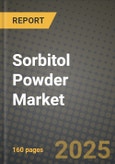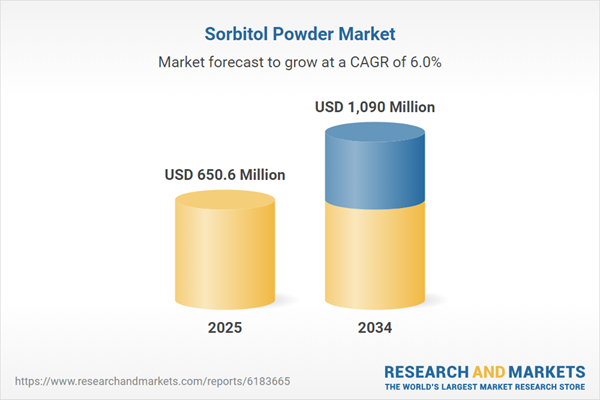Sorbitol Powder Market
Sorbitol powder is a crystalline polyol derived from glucose hydrogenation, valued for its mild sweetness, humectancy, and strong compressibility. It is widely used across confectionery, bakery, and oral care (notably toothpaste and sugar-free gum), as well as in pharmaceuticals and nutraceuticals for direct-compression tablets, chewables, and vitamin/mineral blends. In food and beverages, it functions as a bulk sweetener and texture modifier in sugar-reduced formulations, drink mixes, and coatings; in personal care, it supports moisture retention and sensory smoothness. Current trends include accelerated sugar-reduction targets by global brands, clean-label positioning, and the migration to optimized particle engineering (spray-dried, granulated, or agglomerated grades) that improve flowability, dust control, and tablet hardness at lower compression forces. Producers are investing in energy-efficient hydrogenation, catalyst longevity, and tighter quality systems to meet pharmacopeial and cosmetic standards. Demand is reinforced by front-of-pack labeling rules and dental-health claims, while long-term supply dynamics reflect feedstock reliability in corn, wheat, and tapioca starch chains. Competitive intensity remains high, with integrated starch and sweetener companies leveraging multi-plant networks in Asia and Europe, and regional specialists serving local pharma and personal-care accounts. Strategic themes include sustainability in raw-material sourcing and utilities, application support for reformulation, and resilient logistics models that shorten lead times to contract manufacturers and brand owners.Sorbitol Powder Market Key Insights
- Sugar-reduction as a structural growth theme. Brand reformulation in confectionery, bakery, beverages, and dairy alternatives continues to prioritize bulk sweeteners that deliver body and mouthfeel. Sorbitol powder fits as a non-cariogenic humectant with a neutral flavor profile. It blends well with high-intensity sweeteners to reach target sweetness without off-notes. As policies tighten on added sugars, stable powder forms gain preference for dry blends and premixes.
- Pharma and nutraceuticals anchor premium grades. Direct-compression chewables, effervescents, and lozenges favor sorbitol for compactability and smooth mouthfeel. Producers are scaling tight-spec grades aligned to pharmacopeial requirements and nitrosamine-aware risk frameworks. Particle-size distribution control reduces segregation, improving uniformity in high-speed tableting. Technical service is a differentiator, with co-development on hardness, friability, and dissolution.
- Oral care remains a durable demand pool. Toothpaste and mouth-care powders rely on sorbitol for moisture retention, rheology balance, and non-cariogenic claims. Global toothpaste capacity expansions in emerging markets favor reliable, audit-ready suppliers. Powder grades support stable, high-solids formulations and predictable processing. Hygiene and whitening sub-segments sustain baseline offtake across price tiers.
- Process innovation improves cost-to-serve. Advances in continuous hydrogenation, heat-integration, and catalyst management reduce utilities intensity. Upstream starch integration and by-product valorization help buffer feedstock variability. Dust-reduced granules improve handling at customer sites, lowering waste and cleaning cycles. Packaging innovations (liner technology, palletization) protect flowability in humid geographies.
- Feedstock and energy remain core risk levers. Corn and tapioca dynamics, freight availability, and power prices influence conversion costs. Weather patterns can ripple through dextrose availability and premiums for specialty grades. Suppliers mitigate with multi-origin procurement and flexible grind mixes. Long-term agreements with key accounts stabilize plant utilization through cycles.
- Portfolio segmentation widens addressable use-cases. From fine crystalline to agglomerated DC grades, suppliers tailor compressibility, hygroscopicity, and dissolution. Co-processed systems with maltitol, mannitol, or binders target specific chewable and coating needs. In foods, pairing sorbitol with fibers and flavors enhances body and freeze-thaw stability. Modular portfolios allow faster spec-in across co-manufacturers.
- Regulatory and labeling shape formulation choices. Front-of-pack schemes and school-food standards elevate bulk sweeteners that maintain taste with reduced sugars. Dental-health endorsements support confectionery positioning. Tolerance labeling drives portion design in snacks and supplements. Market access aligns with compliance to food-grade, pharma-grade, and cosmetic-grade documentation.
- Sustainability as a procurement criterion. Buyers increasingly score suppliers on renewable energy, water stewardship, and verified agricultural practices. Low-carbon utilities, biomass steam, and circularity claims differentiate in RFPs. Traceability from starch mill to hydrogenation steps is becoming table stakes. Packaging light-weighting and recyclable liners aid scope-3 narratives.
- Competition balances scale and specialization. Large integrated sweetener players leverage global plants, technical centers, and logistics to serve multinationals. Regional champions compete on agility, custom grades, and local regulatory support. Maturity in oral care and pharma stabilizes base volumes, while new product pipelines in snacks and sports nutrition add optionality. Service intensity and quality systems are durable moats.
- Blends and systems win shelf space. Sorbitol’s role in multi-component systems (with high-intensity sweeteners, acids, flavors, and functional fibers) is expanding. Dry beverage mixes, bakery premixes, and coating systems prize predictable flow and low caking. In tablets, co-processed excipients reduce steps and variability on fast lines. Application labs shorten qualification cycles and enhance stickiness.
Sorbitol Powder Market Reginal Analysis
North America
A mature landscape anchored by oral care and pharmaceutical excipients, with steady pull from sugar-reduced confectionery, bakery mixes, and functional beverages. Retail and food-service reformulation accelerates demand for bulk sweeteners that uphold texture without sugar penalties. Contract manufacturers favor DC-optimized grades to support high-speed tableting and gummy formats. Procurement emphasizes supplier auditability, allergen-free operations, and documented sustainability progress, with nearshoring logistics reducing lead-time risk.Europe
Regulatory focus on nutrition profiling and dental-health positioning supports sorbitol’s use in sugar-reduced categories and gum. Pharma excipient standards and serialization ecosystems favor suppliers with deep quality documentation. Clean-label and plant-based trends push adoption in bakery, bars, and nutritional supplements, while specialty confectionery maintains baseline volumes. Energy stewardship and decarbonization pathways increasingly influence supplier selection and long-term contracts.Asia-Pacific
The manufacturing hub for starch derivatives and polyols, with extensive capacity in China, India, and Southeast Asia supporting both domestic demand and exports. Fast-growing confectionery, drink mixes, and personal-care categories benefit from modern retail and e-commerce channels. Localization of pharma and nutraceutical production raises the bar for grade consistency and regulatory readiness. Competitive pricing coexists with rapid innovation in particle engineering and packaging designed for humid climates.Middle East & Africa
Market development is driven by expanding oral care penetration, modern trade formats, and rising demand for shelf-stable confectionery and bakery goods. Many countries remain import-reliant, making distributor partnerships and inventory positioning critical. Industrial customers value moisture-resistant packaging and predictable dissolution in high-temperature environments. Halal compliance, technical training, and application support are levers for supplier differentiation.South & Central America
Sugar-intake policies and retailer reformulation programs underpin demand in beverages, confectionery, and bakery premixes. Regional starch availability combined with selective imports shapes pricing and grade choices. Co-manufacturers serving multinational brands seek stable DC grades for chewables, lozenges, and fortified formats. Supply reliability, lead-time management during seasonal peaks, and after-sales technical support drive supplier stickiness across key corridors.Sorbitol Powder Market Segmentation
By Type
- Pan-agglomerated Sorbitol
- Spray-dried Sorbitol
By Application
- Oral Care
- Vitamin C
- Diabetic Food and Beverage
- Surfactant
- Others
By End-User
- Personal Care
- Chemical
- Food
- Pharmaceuticals
- Others
Key Market players
Roquette Frères, Cargill, ADM (Archer Daniels Midland), Ingredion Incorporated, Tereos, Gulshan Polyols Ltd., Gujarat Ambuja Exports Ltd. (GAEL), Sukhjit Starch & Chemicals Ltd., Shandong Futaste Pharmaceutical Co., Ltd., Shandong Luwei Pharmaceutical Co., Ltd., Shandong Baolingbao Biology Co., Ltd., Dancheng Caixin Sugar Industry Co., Ltd., PT Sorini Agro Asia Corporindo Tbk, Kasyap Sweeteners Ltd., SPI Pharma Inc.Sorbitol Powder Market Analytics
The report employs rigorous tools, including Porter’s Five Forces, value chain mapping, and scenario-based modelling, to assess supply-demand dynamics. Cross-sector influences from parent, derived, and substitute markets are evaluated to identify risks and opportunities. Trade and pricing analytics provide an up-to-date view of international flows, including leading exporters, importers, and regional price trends.Macroeconomic indicators, policy frameworks such as carbon pricing and energy security strategies, and evolving consumer behaviour are considered in forecasting scenarios. Recent deal flows, partnerships, and technology innovations are incorporated to assess their impact on future market performance.
Sorbitol Powder Market Competitive Intelligence
The competitive landscape is mapped through proprietary frameworks, profiling leading companies with details on business models, product portfolios, financial performance, and strategic initiatives. Key developments such as mergers & acquisitions, technology collaborations, investment inflows, and regional expansions are analyzed for their competitive impact. The report also identifies emerging players and innovative startups contributing to market disruption.Regional insights highlight the most promising investment destinations, regulatory landscapes, and evolving partnerships across energy and industrial corridors.
Countries Covered
- North America - Sorbitol Powder market data and outlook to 2034
- United States
- Canada
- Mexico
- Europe - Sorbitol Powder market data and outlook to 2034
- Germany
- United Kingdom
- France
- Italy
- Spain
- BeNeLux
- Russia
- Sweden
- Asia-Pacific - Sorbitol Powder market data and outlook to 2034
- China
- Japan
- India
- South Korea
- Australia
- Indonesia
- Malaysia
- Vietnam
- Middle East and Africa - Sorbitol Powder market data and outlook to 2034
- Saudi Arabia
- South Africa
- Iran
- UAE
- Egypt
- South and Central America - Sorbitol Powder market data and outlook to 2034
- Brazil
- Argentina
- Chile
- Peru
Research Methodology
This study combines primary inputs from industry experts across the Sorbitol Powder value chain with secondary data from associations, government publications, trade databases, and company disclosures. Proprietary modeling techniques, including data triangulation, statistical correlation, and scenario planning, are applied to deliver reliable market sizing and forecasting.Key Questions Addressed
- What is the current and forecast market size of the Sorbitol Powder industry at global, regional, and country levels?
- Which types, applications, and technologies present the highest growth potential?
- How are supply chains adapting to geopolitical and economic shocks?
- What role do policy frameworks, trade flows, and sustainability targets play in shaping demand?
- Who are the leading players, and how are their strategies evolving in the face of global uncertainty?
- Which regional “hotspots” and customer segments will outpace the market, and what go-to-market and partnership models best support entry and expansion?
- Where are the most investable opportunities - across technology roadmaps, sustainability-linked innovation, and M&A - and what is the best segment to invest over the next 3-5 years?
Your Key Takeaways from the Sorbitol Powder Market Report
- Global Sorbitol Powder market size and growth projections (CAGR), 2024-2034
- Impact of Russia-Ukraine, Israel-Palestine, and Hamas conflicts on Sorbitol Powder trade, costs, and supply chains
- Sorbitol Powder market size, share, and outlook across 5 regions and 27 countries, 2023-2034
- Sorbitol Powder market size, CAGR, and market share of key products, applications, and end-user verticals, 2023-2034
- Short- and long-term Sorbitol Powder market trends, drivers, restraints, and opportunities
- Porter’s Five Forces analysis, technological developments, and Sorbitol Powder supply chain analysis
- Sorbitol Powder trade analysis, Sorbitol Powder market price analysis, and Sorbitol Powder supply/demand dynamics
- Profiles of 5 leading companies - overview, key strategies, financials, and products
- Latest Sorbitol Powder market news and developments
Additional Support
With the purchase of this report, you will receive:- An updated PDF report and an MS Excel data workbook containing all market tables and figures for easy analysis.
- 7-day post-sale analyst support for clarifications and in-scope supplementary data, ensuring the deliverable aligns precisely with your requirements.
- Complimentary report update to incorporate the latest available data and the impact of recent market developments.
This product will be delivered within 1-3 business days.
Table of Contents
Companies Mentioned
- Roquette Frères
- Cargill
- ADM (Archer Daniels Midland)
- Ingredion Incorporated
- Tereos
- Gulshan Polyols Ltd.
- Gujarat Ambuja Exports Ltd. (GAEL)
- Sukhjit Starch & Chemicals Ltd.
- Shandong Futaste Pharmaceutical Co. Ltd.
- Shandong Luwei Pharmaceutical Co. Ltd.
- Shandong Baolingbao Biology Co. Ltd.
- Dancheng Caixin Sugar Industry Co. Ltd.
- PT Sorini Agro Asia Corporindo Tbk
- Kasyap Sweeteners Ltd.
- SPI Pharma Inc.
Table Information
| Report Attribute | Details |
|---|---|
| No. of Pages | 160 |
| Published | November 2025 |
| Forecast Period | 2025 - 2034 |
| Estimated Market Value ( USD | $ 650.6 Million |
| Forecasted Market Value ( USD | $ 1090 Million |
| Compound Annual Growth Rate | 6.0% |
| Regions Covered | Global |
| No. of Companies Mentioned | 15 |









